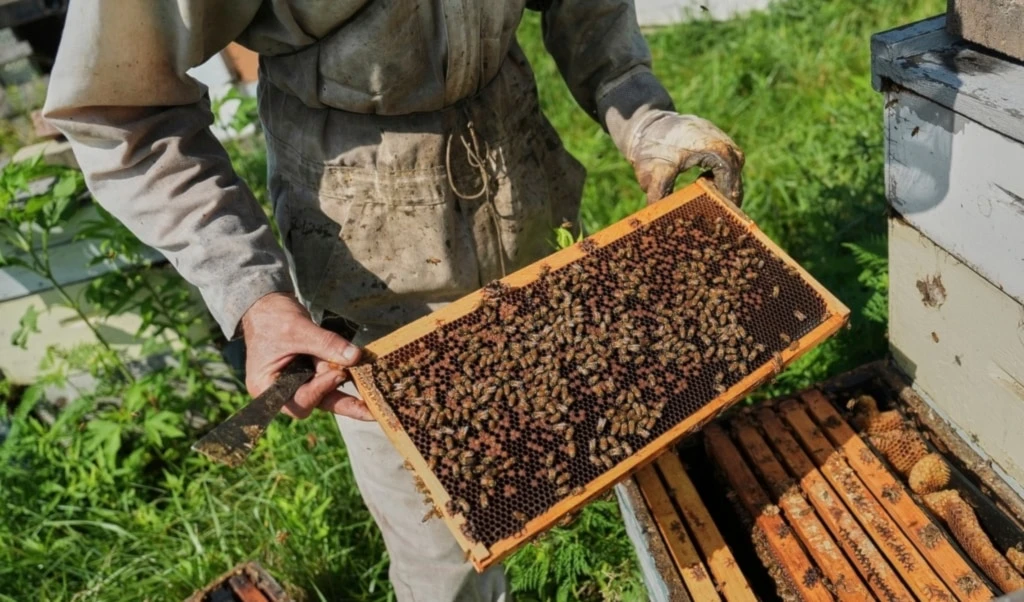Wild bee species at existential risk in Europe doubles in past decade
Butterfly species are also declining due to climate change, agriculture, and habitat loss.
-

In this May 5, 2020, photo, a bee collects pollen from an apple blossom at Stocks Farm in Suckley, Worcestershire (AP)
The number of wild bee species facing extinction in Europe has more than doubled over the past decade, according to new research for the International Union for Conservation of Nature (IUCN). Out of 1,928 known wild bee species on the continent, at least 172 are now at risk of extinction.
The study also found that the number of butterfly species endangered in Europe has nearly doubled over the same period. Since the last comprehensive assessment 14 years ago, the number of threatened butterfly species has risen from 37 to 65. One species, the Madeiran large white (Pieris wollastoni), has already been declared extinct.
“Butterflies and bees are lifelines for our health, our food systems, and our economies – sustaining the fruits, vegetables and seeds that nourish us,” Grethel Aguilar, IUCN Director General, told The Guardian. “The latest European red list assessments reveal serious challenges, with threats mounting for butterflies and crucial wild bee species.”
According to the data, 52% of endangered butterfly species in Europe are now threatened by global heating, double the figure from a decade ago. High-altitude species such as the Nevada grayling and the Andalusian anomalous blue are especially vulnerable, as they are pushed uphill by rising temperatures until no viable habitat remains.
Read more: Bees in Iraq’s Basra threatened by water crisis and declining honey
Key causes: Agriculture, chemicals, and global heating
The accelerating bee extinction and decline in butterfly species are primarily driven by habitat destruction linked to agricultural intensification, the use of pesticides, such as neonicotinoids, wetland drainage, overgrazing, and land abandonment. These practices have fragmented pollinator-friendly environments, increasing the risk of local extinctions and severely impacting bee colony populations.
Dr. Denis Michez, lead coordinator of the wild bee assessment, stressed to The Guardian the ecological consequences, stating, “Wild bee populations are in drastic decline and cannot be easily replaced by managed colonies. If wild bees disappear, many wild plants might be at risk too – of which flower-rich meadows and beautiful orchid species are just a few examples.”
Europe's mountainous and Arctic regions are becoming increasingly hostile to pollinators. In the Mediterranean, critically endangered species like the Karpathos grayling face extreme drought and frequent wildfires. In the Arctic Circle, rising temperatures are shifting tree lines northward and transforming tundra landscapes, while limiting reindeer grazing that helps preserve open grasslands. Eight butterfly species are currently threatened in this fragile region, including Freyja’s fritillary and the Arctic ringlet.
Read more: New Zealand’s oceans warming 34% faster than global average: Report
EU response and hope for pollinator recovery
Martin Warren, a lead coordinator of the butterfly assessment, highlighted to The Guardian the growing public concern and political action. “Under the EU nature restoration legislation, all member states have to reverse the decline in pollinators by 2030. There are landowners who are interested. Let’s hope they can get the incentives that will help them on their way," he said.
Warren also pointed out that restoring flower-rich grasslands around agricultural fields is a low-cost and effective step that can benefit both pollinators and crop yields.
EU Commissioner for Environment, Jessika Roswall, described the conservation status of bees, butterflies, and other pollinators as “dire", urging urgent cooperation among member states. A continent-wide monitoring system has been established to track progress, supported by the EU nature restoration regulation.
The release of these findings follows a similar Europe-wide study on hoverflies, published in 2022, which revealed that 37% of all hoverfly species are also at risk of extinction.

 4 Min Read
4 Min Read










